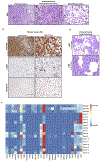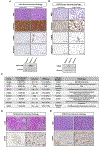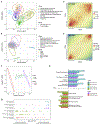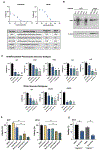Genetic Screen in a Preclinical Model of Sarcoma Development Defines Drivers and Therapeutic Vulnerabilities
- PMID: 39177582
- PMCID: PMC11530313
- DOI: 10.1158/1078-0432.CCR-24-1238
Genetic Screen in a Preclinical Model of Sarcoma Development Defines Drivers and Therapeutic Vulnerabilities
Abstract
Purpose: High-grade complex karyotype sarcomas are a heterogeneous group of tumors with a uniformly poor prognosis. Within complex karyotype sarcomas, there are innumerable genetic changes but identifying those that are clinically relevant has been challenging.
Experimental design: To address this, we utilized a pooled genetic screening approach, informed by The Cancer Genome Atlas (TCGA) data, to identify key drivers and modifiers of sarcoma development that were validated in vivo.
Results: YAP1 and wild-type KRAS were validated as drivers and transformed human mesenchymal stem cells into two distinct sarcoma subtypes, undifferentiated pleomorphic sarcoma and myxofibrosarcoma, respectively. A subset of tumors driven by CDK4 and PIK3CA reflected leiomyosarcoma and osteosarcoma demonstrating the plasticity of this approach and the potential to investigate sarcoma subtype heterogeneity. All generated tumors histologically reflected human sarcomas and had increased aneuploidy as compared to simple karyotype sarcomas. Comparing differential gene expression of TCGA samples to model data identified increased oxidative phosphorylation signaling in YAP1 tumors. Treatment of a panel of soft tissue sarcomas with a combination of YAP1 and oxidative phosphorylation inhibitors led to significantly decreased viability.
Conclusions: Transcriptional co-analysis of TCGA patient samples to YAP1 and KRAS model tumors supports that these sarcoma subtypes lie along a spectrum of disease and adds guidance for further transcriptome-based refinement of sarcoma subtyping. This approach can be used to begin to understand pathways and mechanisms driving human sarcoma development, the relationship between sarcoma subtypes, and to identify and validate new therapeutic vulnerabilities for this aggressive and heterogeneous disease.
©2024 American Association for Cancer Research.
Conflict of interest statement
T.G.G. reports having consulting and equity agreements with Auron Therapeutics, Boundless Bio, Coherus BioSciences and Trethera Corporation. O.N.W. currently has consulting, equity, and/or board relationships with Trethera Corporation, Kronos Biosciences, Sofie Biosciences, Breakthrough Properties, Vida Ventures, Nammi Therapeutics, Two River, Iconovir, Appia BioSciences, Neogene Therapeutics, 76Bio, and Allogene Therapeutics. S.W.T. receives clinical trial funding from McMaster.
Figures






Similar articles
-
YAP1 Status Defines Two Intrinsic Subtypes of LCNEC with Distinct Molecular Features and Therapeutic Vulnerabilities.Clin Cancer Res. 2024 Oct 15;30(20):4743-4754. doi: 10.1158/1078-0432.CCR-24-0361. Clin Cancer Res. 2024. PMID: 39150543
-
Prevalence of the Hippo Effectors YAP1/TAZ in Tumors of Soft Tissue and Bone.Sci Rep. 2019 Dec 23;9(1):19704. doi: 10.1038/s41598-019-56247-8. Sci Rep. 2019. PMID: 31873172 Free PMC article.
-
YAP1 enhances NF-κB-dependent and independent effects on clock-mediated unfolded protein responses and autophagy in sarcoma.Cell Death Dis. 2018 Oct 31;9(11):1108. doi: 10.1038/s41419-018-1142-4. Cell Death Dis. 2018. PMID: 30382078 Free PMC article.
-
YAP1 and its fusion proteins in cancer initiation, progression and therapeutic resistance.Dev Biol. 2021 Jul;475:205-221. doi: 10.1016/j.ydbio.2020.12.018. Epub 2021 Jan 8. Dev Biol. 2021. PMID: 33428889 Free PMC article. Review.
-
Uterine sarcomas and rare uterine mesenchymal tumors with malignant potential. Diagnostic guidelines of the French Sarcoma Group and the Rare Gynecological Tumors Group.Gynecol Oncol. 2022 Nov;167(2):373-389. doi: 10.1016/j.ygyno.2022.07.031. Epub 2022 Sep 14. Gynecol Oncol. 2022. PMID: 36114030 Review.
References
-
- WHO Classification of Tumours Editorial Board (2020). Soft Tissue and Bone Tumours WHO Classification of Tumours 5th Edition, Volume 3.
MeSH terms
Substances
Grants and funding
- P30 CA093373/CA/NCI NIH HHS/United States
- 5K12-CA138464/National Cancer Institute (NCI)
- T32 GM145388/GM/NIGMS NIH HHS/United States
- Howard Hughes Medical Institute (HHMI)
- RO1CA222877/National Cancer Institute (NCI)
- T32 GM135741/GM/NIGMS NIH HHS/United States
- T32GM135741/National Institutes of Health (NIH)
- W. M. Keck Foundation (WMKF)
- P01 GM099134/GM/NIGMS NIH HHS/United States
- T32AR079099/National Institute of Arthritis and Musculoskeletal and Skin Diseases (NIAMS)
- K12 CA138464/CA/NCI NIH HHS/United States
- Burroughs Wellcome Fund (BWF)
- T32 AR079099/AR/NIAMS NIH HHS/United States
- P50 CA092131/CA/NCI NIH HHS/United States
- GM099134/National Institutes of Health (NIH)
- Doris Duke Charitable Foundation (DDCF)
- T32GM145388/National Institutes of Health (NIH)
- Alan B. Slifka Foundation
- R01 CA222877/CA/NCI NIH HHS/United States
LinkOut - more resources
Full Text Sources
Medical
Molecular Biology Databases
Research Materials
Miscellaneous

